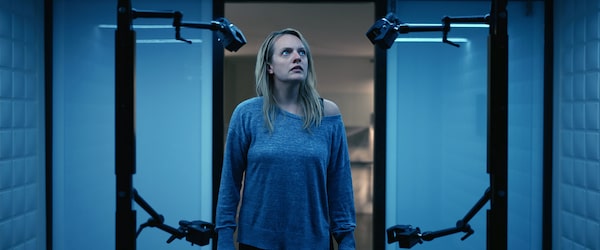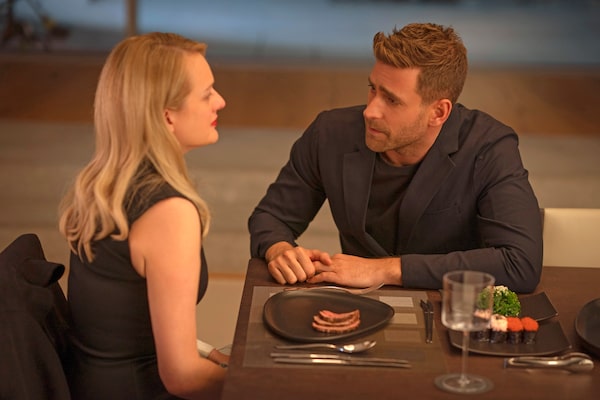
The Invisible Man features Cecilia Kass (played by Elisabeth Moss), a woman who manages to leave her physically and emotionally abusive relationship.Photo Credit: Universal Pictures/Universal Pictures
- The Invisible Man
- Directed by Leigh Whannell
- Written by Leigh Whannell, Ed Solomon, David S. Goyer, Robert Ramsey, Matthew Stone, H.G. Wells
- Starring Elisabeth Moss and Aldis Hodge
- Classification 18A; 125 minutes

Kass goes on to be further subjected to abuse when her former partner, Adrian Griffin, fakes his own death in order to torment her as an invisible entity.Photo Credit: Mark Rogers/Univer/Universal Pictures
Leigh Whannell’s newest flick, The Invisible Man, takes on H.G. Wells’s oft-mined novel and reorients it more literally toward a narrative wherein scientific ingenuity is just one of many tools of abuse. The Insidious: Chapter 3 director and noted Saw alum’s revisionist take centres on Cecilia Kass (Elisabeth Moss), a woman who manages to leave her physically and emotionally abusive relationship. But she goes on to be further subjected to abuse when her former partner, Adrian Griffin (Oliver Jackson-Cohen), a highly successful optics specialist and tech company founder, fakes his own death in order to torment her as an invisible entity.
There’s not much space given in the film to exactly how Adrian has come to achieve his invisibility – in fact, there’s not much thought given toward the construction of an expansive and steady narrative at all. In many ways, this works to the benefit of what are surely the film’s aims: to have its audience identify with Cecilia from her first appearance onscreen and, in counter to this, to disallow any chance at what we might call humanization of Adrian’s character. These ideas are all well and good. Indeed, the way the film navigates Cecilia, not only in the story world, but even her positioning on the screen – her physical relationship and scale in relation to her environment and other characters – is notable in that it underscores the violence she is subjected to.
But alongside this, I wonder why it seems so hard for screenwriters to develop a character who is a victim of abuse without making it that character’s be all and end all. Whannell’s film jumps into this dynamic from its very first scene. Soon after, Adrian’s invisibility is not just hinted at, but realized and confirmed. While it’s refreshing to see a film not waste time with dead-end hypotheses of ghosts (for once, it seems), it also hinders its audience from gaining any sense of who Cecilia is outside of the abuse that happens to her.

There’s not much space given in the film to exactly how Adrian, played by Oliver Jackson-Cohen, has come to achieve his invisibility.Photo Credit: Mark Rogers/Univer/Universal Pictures
Her relationships with others are clumsily arranged in the film, to the point that the writing comes off as too impatient to flesh out its own world. We learn, almost accidentally, that she is an architect when her attempts to apply for a job are thwarted by Adrian; we deduce that she might have some sort of strained past with her sister, who refuses to give Cecilia the benefit of the doubt. I, frankly, am still confused by where several characters fit within Cecilia’s orbit. The film is overly eager to get to its main action at the expense of its story and, with Adrian’s abuse being the film’s guiding narrative current, it needs to resist this impulsive tendency and instead reflect on the nuances implicitly at work within such an experience of violence. Despite Whannell’s recent comments that he sees his script as a collaborative effort between him and Moss, there doesn’t seem to be much thought toward outlining who Cecilia is outside of what we see her subjected to.
As for its more enjoyable qualities, The Invisible Man is a great example of the power of a jump scare and how to show or, even more importantly, not show, characters onscreen (both well-established strengths of Whannell’s long-time collaborator, James Wan). In its best moments, the film is successful at enacting horror and conveying an invisible entity in a way that borders on excruciating, but it also suffers from visual effects that are unfortunately evocative of the level of visual sophistication previously seen in an earlier Wells spin, the Kevin Bacon-helmed Hollow Man. As the film progresses and positions itself closer and closer to visualizing what Adrian might look like, it also becomes more cartoonish. Adrian comes to be rendered almost as if he were a comic-book villain, which severely undermines the weight of the story.

There also doesn’t seem to have been much thought given to outlining who Cecilia is outside of the abuse we see her subjected to onscreen.Photo Credit: Mark Rogers/Univer/Universal Pictures
It’s very disappointing to watch a movie attempt, however unsuccessfully, a take on women’s experience of abuse with a heavy tone of sincerity, while also making its abuser look like some sort of high-tech, minimalist Spawn-lite. This is one of several turns in the film, including a dash of reproductive coercion for shock value, that completely break down any sense of sincerity or goodwill it might’ve had toward Cecilia’s character. As a result, the film struggles with its change in tone and, by movie’s end, can’t quite seem to reconcile its conflicting ambitions. While chock full of relatively good scares, campy effects, and an ending that will tickle a very specific demographic of 1990s and 2000s thriller fans with glee, The Invisible Man doesn’t deliver more than that.
The Invisible Man opens across Canada on February 28
Plan your screen time with the weekly What to Watch newsletter, with film, TV and streaming reviews and more. Sign up today.